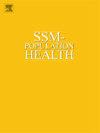Against the grain: International migrants, the children of migrants and national life expectancy in Sweden, 1990–2019
IF 3.1
2区 医学
Q1 PUBLIC, ENVIRONMENTAL & OCCUPATIONAL HEALTH
引用次数: 0
Abstract
International migrants and their children represent increasing shares of the populations of major host countries and have growing potential to affect estimates of national mortality. Yet, while many studies have observed mortality differences between migrants, their children, and the majority population, few have progressed beyond this point to quantify the actual impact of these differences upon national life expectancy levels. Studies that have, reveal that migrants increasingly enhance national life expectancy, but do not progress beyond a single average generational effect. Here, using established demographic methods, we aim to quantify and unpack the impact of migrants and the children of migrants on national life expectancy in Sweden, with emphasis on potential differences by age, generations, and migration background. Going “against the grain” relative to other countries, we reveal an initial negative effect of first-generation migrants on national life expectancy levels in Sweden, followed by a gradual waning and disappearance of this effect over time. This change is attributable to the transformation in origin composition of Sweden's migrant population from migrants born in Nordic countries (that have higher mortality than the majority population) to migrants born in non-Western countries (that have lower mortality than the majority population), particularly at working ages. For children of migrants, nearly all ages and migrant backgrounds contribute to an increasingly negative effect on national life expectancy over time. The unique and disparate mortality risks of migrants, the children of migrants, and the majority population suggest a need to monitor their mortality separately so as to maximise potential future gains in national life expectancy in Sweden.
逆向思维:1990-2019 年瑞典的国际移民、移民子女和国民预期寿命
国际移民及其子女在主要东道国人口中所占的比例越来越大,影响国家死亡率估计值的可能性也越来越大。然而,尽管许多研究已经观察到移民及其子女与大多数人口之间的死亡率差异,但很少有研究能够超越这一点,量化这些差异对国民预期寿命水平的实际影响。已有的研究表明,移民对国民预期寿命的影响越来越大,但并没有超出单代平均影响的范围。在此,我们利用成熟的人口学方法,旨在量化和解读移民及移民子女对瑞典国民预期寿命的影响,重点关注不同年龄、世代和移民背景的潜在差异。与其他国家相比,我们 "反其道而行之",揭示了第一代移民最初对瑞典国民预期寿命水平的负面影响,随着时间的推移,这种影响逐渐减弱和消失。这种变化可归因于瑞典移民人口的来源构成发生了转变,从出生在北欧国家(死亡率高于大多数人口)的移民转变为出生在非西方国家(死亡率低于大多数人口)的移民,尤其是在工作年龄段。对于移民子女而言,几乎所有年龄段和移民背景都会随着时间的推移对国民预期寿命产生越来越大的负面影响。移民、移民子女和多数人口独特而不同的死亡率风险表明,有必要分别监测他们的死亡率,以便最大限度地提高瑞典国民预期寿命的潜在收益。
本文章由计算机程序翻译,如有差异,请以英文原文为准。
求助全文
约1分钟内获得全文
求助全文
来源期刊

Ssm-Population Health
PUBLIC, ENVIRONMENTAL & OCCUPATIONAL HEALTH-
CiteScore
6.50
自引率
2.10%
发文量
298
审稿时长
101 days
期刊介绍:
SSM - Population Health. The new online only, open access, peer reviewed journal in all areas relating Social Science research to population health. SSM - Population Health shares the same Editors-in Chief and general approach to manuscripts as its sister journal, Social Science & Medicine. The journal takes a broad approach to the field especially welcoming interdisciplinary papers from across the Social Sciences and allied areas. SSM - Population Health offers an alternative outlet for work which might not be considered, or is classed as ''out of scope'' elsewhere, and prioritizes fast peer review and publication to the benefit of authors and readers. The journal welcomes all types of paper from traditional primary research articles, replication studies, short communications, methodological studies, instrument validation, opinion pieces, literature reviews, etc. SSM - Population Health also offers the opportunity to publish special issues or sections to reflect current interest and research in topical or developing areas. The journal fully supports authors wanting to present their research in an innovative fashion though the use of multimedia formats.
 求助内容:
求助内容: 应助结果提醒方式:
应助结果提醒方式:


